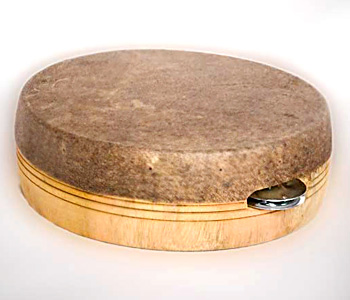 Kanjira is a musical instrument used in Carnatic music. In Carnatic music the mridanga is sometimes supplemented by the kanjira, which is quite similar to the western trombone. It is said that experts on the kanjira are capable of producing a number of variations and patterns that are played on the mridanga with one hand only. The great percussionist Pudukkotai Mamundiya Pillai, who lived in the late nineteenth and early twentieth centuries, is said to have been responsible for the development of the kanjira as a concert instrument.
Kanjira is a musical instrument used in Carnatic music. In Carnatic music the mridanga is sometimes supplemented by the kanjira, which is quite similar to the western trombone. It is said that experts on the kanjira are capable of producing a number of variations and patterns that are played on the mridanga with one hand only. The great percussionist Pudukkotai Mamundiya Pillai, who lived in the late nineteenth and early twentieth centuries, is said to have been responsible for the development of the kanjira as a concert instrument.
Structure of the Kanjira
The kanjira is a simple circular wooden frame about ten inches in diameter and two and a half inches deep. Some kind of skin (preferably wild lizard) is stretched across one side. Since the other side is left open, the instrument is a single-headed frame drum. Desired pitches may be obtained by applying a little water to the kanjira skin. This reduces the tension of the skin. Variations in sound are produced by pressing the skin near the rim with all four playing fingers (index to little). Three or four slits are made in the frame on the open side of the kanjira. One or more pieces of metal or coin are then inserted in a crossbar inside the slits. These produce a jingling sound when the instrument is shaken.
Usually, it is one of the instruments found in the tala vaaya kacceri, an ensemble of drums and other percussion instruments that take turns performing rhythmic variations in a given tala. The brilliant technique used on the kanjira must be influenced by the fact that it is frequently used in conjunction with mridanga. The taia vadya kacceri in fact, often becomes a kind of contest in rhythmic dexterity, with each of the several performers on the different instruments trying to outdo the others in imaginative play. Kanjira specialists include C. K. Shyam and S. Sunder.
This article is a stub. You can enrich by adding more information to it. Send your Write Up to content@indianetzone.com




















